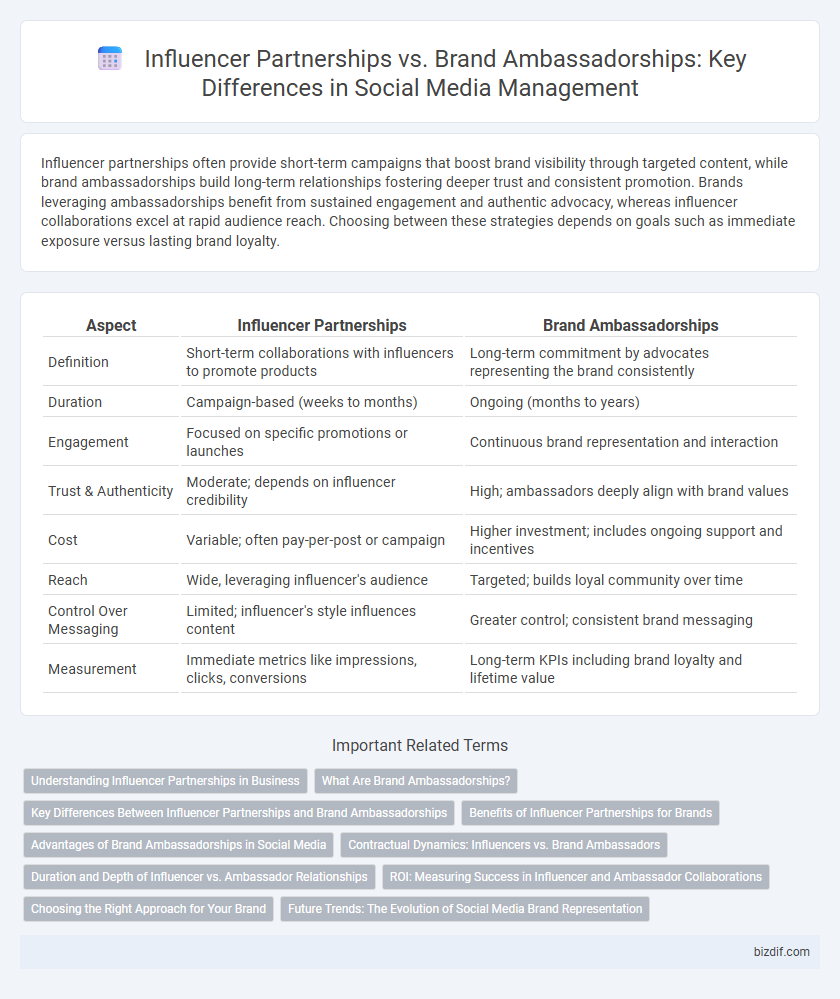Influencer partnerships often provide short-term campaigns that boost brand visibility through targeted content, while brand ambassadorships build long-term relationships fostering deeper trust and consistent promotion. Brands leveraging ambassadorships benefit from sustained engagement and authentic advocacy, whereas influencer collaborations excel at rapid audience reach. Choosing between these strategies depends on goals such as immediate exposure versus lasting brand loyalty.
Table of Comparison
| Aspect | Influencer Partnerships | Brand Ambassadorships |
|---|---|---|
| Definition | Short-term collaborations with influencers to promote products | Long-term commitment by advocates representing the brand consistently |
| Duration | Campaign-based (weeks to months) | Ongoing (months to years) |
| Engagement | Focused on specific promotions or launches | Continuous brand representation and interaction |
| Trust & Authenticity | Moderate; depends on influencer credibility | High; ambassadors deeply align with brand values |
| Cost | Variable; often pay-per-post or campaign | Higher investment; includes ongoing support and incentives |
| Reach | Wide, leveraging influencer's audience | Targeted; builds loyal community over time |
| Control Over Messaging | Limited; influencer's style influences content | Greater control; consistent brand messaging |
| Measurement | Immediate metrics like impressions, clicks, conversions | Long-term KPIs including brand loyalty and lifetime value |
Understanding Influencer Partnerships in Business
Influencer partnerships involve collaborations where influencers promote products or services for a limited time, often through sponsored posts or campaigns, driving immediate brand awareness and sales. These partnerships are typically transactional, focusing on reach and engagement metrics across platforms like Instagram, TikTok, and YouTube. Businesses leverage influencer partnerships to target specific audiences quickly, enhance credibility, and boost short-term marketing objectives.
What Are Brand Ambassadorships?
Brand ambassadorships involve long-term collaborations where influencers consistently represent a brand, embodying its values and message across various platforms. These partnerships go beyond single campaigns, fostering authentic connections that build trust and loyalty among target audiences. Brands benefit from ongoing ambassador advocacy through increased brand awareness, credibility, and sustained engagement.
Key Differences Between Influencer Partnerships and Brand Ambassadorships
Influencer partnerships are typically short-term collaborations focused on specific campaigns or product launches, leveraging the influencer's reach to boost brand visibility quickly. Brand ambassadorships involve long-term relationships where ambassadors consistently promote the brand's values and products, creating sustained trust and loyalty among their audience. The key differences lie in the duration, commitment level, and depth of brand integration, with ambassadorships fostering deeper emotional connections compared to the transactional nature of influencer partnerships.
Benefits of Influencer Partnerships for Brands
Influencer partnerships offer brands targeted reach by leveraging influencers' authentic connections with niche audiences, enhancing brand visibility and engagement organically. These collaborations provide measurable ROI through trackable campaigns, allowing brands to optimize marketing strategies with real-time data. Influencer partnerships also enable brands to access diverse content styles and creative approaches, increasing the potential for viral marketing and stronger audience trust.
Advantages of Brand Ambassadorships in Social Media
Brand ambassadorships foster long-term relationships that enhance brand loyalty and authenticity, resulting in consistent and credible social media content. Brand ambassadors often have a deeper understanding of the company's values, enabling them to create more genuine engagement with their audience. This sustained presence on platforms like Instagram, TikTok, and YouTube drives higher trust and stronger consumer connections than one-off influencer partnerships.
Contractual Dynamics: Influencers vs. Brand Ambassadors
Influencer partnerships typically involve short-term contracts focusing on specific campaigns with clearly defined deliverables and metrics, allowing brands swift flexibility. Brand ambassadorships involve longer-term, often exclusive agreements that embed the individual deeply within the brand's identity, fostering consistent representation and authentic advocacy. Contractual terms for brand ambassadors usually include performance incentives, content ownership clauses, and non-compete agreements, reflecting a strategic commitment beyond transactional marketing.
Duration and Depth of Influencer vs. Ambassador Relationships
Influencer partnerships typically involve short-term collaborations focused on specific campaigns or product launches, offering immediate exposure and targeted engagement. Brand ambassadorships establish long-term relationships, fostering deeper emotional connections and sustained brand loyalty through continuous promotion and authentic representation. The duration and depth of these relationships significantly impact audience trust, with ambassadorships generally driving higher retention and lifetime customer value.
ROI: Measuring Success in Influencer and Ambassador Collaborations
Influencer partnerships often yield immediate ROI through targeted campaigns and measurable engagement metrics, while brand ambassadorships foster long-term loyalty and consistent brand representation, enhancing lifetime customer value. Tracking KPIs such as conversion rates, follower growth, and sentiment analysis provides clear insight into the effectiveness of each collaboration type. Optimizing budget allocation between influencers and ambassadors depends on aligning these metrics with overall marketing objectives and customer acquisition costs.
Choosing the Right Approach for Your Brand
Influencer partnerships offer short-term, campaign-specific collaborations with influencers who have targeted audiences, providing immediate visibility and engagement boosts. Brand ambassadorships involve long-term relationships where ambassadors consistently represent and promote the brand, fostering deeper trust and authentic loyalty. Selecting the right approach depends on your brand's marketing goals, budget, and desired level of audience connection, with influencer partnerships suited for quick reach and ambassadorships ideal for sustained brand advocacy.
Future Trends: The Evolution of Social Media Brand Representation
Influencer partnerships will increasingly diversify across micro and nano-influencers, leveraging authentic engagement and niche audiences for targeted brand reach. Brand ambassadorships will evolve into long-term collaborations emphasizing deeper alignment with brand values, driving consistent storytelling and loyalty. Emerging trends highlight integration with augmented reality (AR) and artificial intelligence (AI) tools to enhance personalized brand representation and real-time audience interaction.
Influencer partnerships vs Brand ambassadorships Infographic

 bizdif.com
bizdif.com